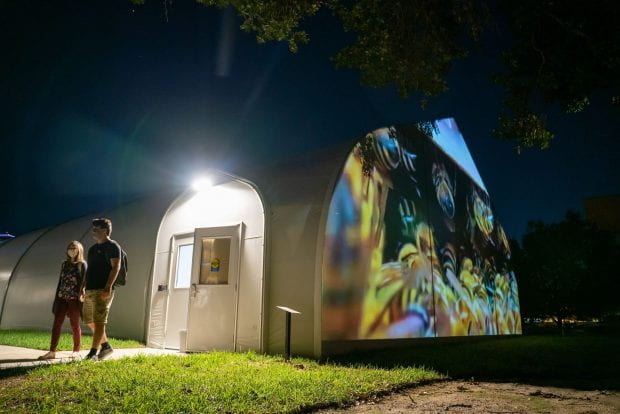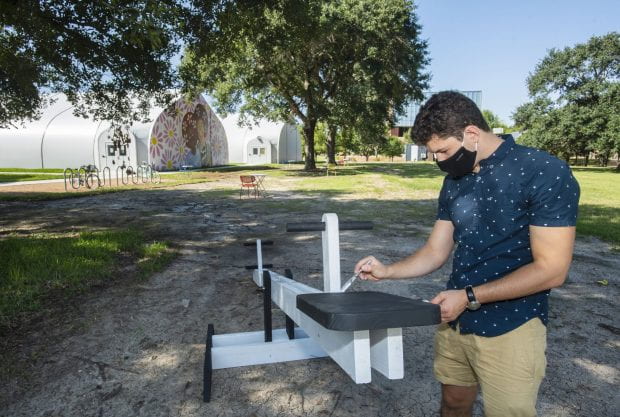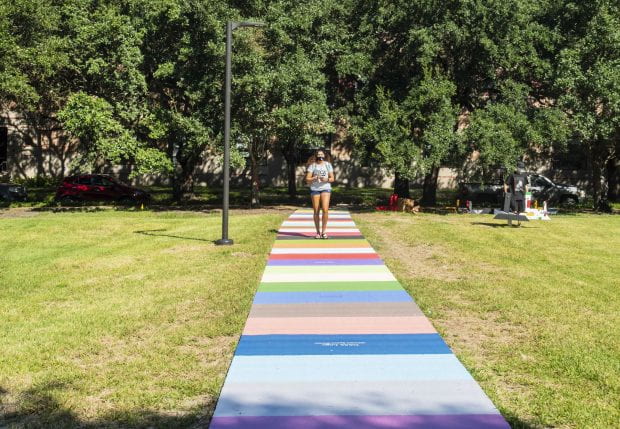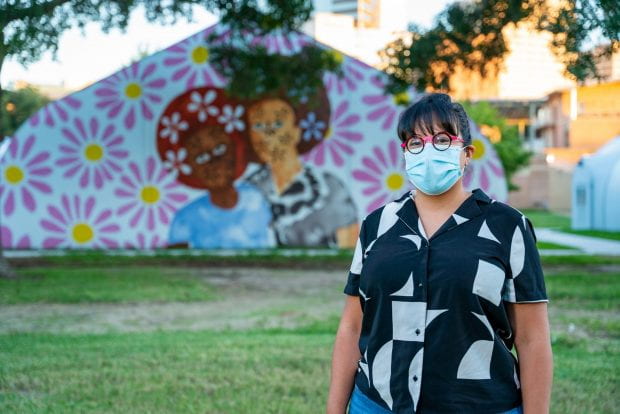A corner of the Rice campus is now a citywide arts destination
The provisional campus facilities (PCFs) now serving as temporary classroom spaces at Rice during the ongoing pandemic could easily have been left as they were built: tall, steel-framed, silvery-white structures tucked behind a row of live oak trees near Hanszen College at the corner of College Way and Alumni Drive.
Instead, the structures and the lawn outside are now pulling double duty as vibrant public art installation spaces. Rice’s newest art attraction came to campus thanks to an interdisciplinary committee organized by the Moody Center for the Arts, which houses the Rice Public Art program. All of the projects are open to the public and will be on view through May 2021.
Two of the PCFs have been transformed into giant canvases for the work of Houston artists Allison Hunter and Jasmine Zelaya. A long sidewalk leading to them has been covered by an imaginative piece from the Color Factory. Brightly painted seesaws created by students in the School of Architecture dot the lawn.
“As part of Rice’s Public Art program, we were inspired to activate these temporary structures with creative interventions,” said Alison Weaver, the Suzanne Deal Booth Executive Director of the Moody Center. “So we reached out to faculty and students and local artists to come up with different projects that would speak to the moment that we’re living in.”
Hunter, artist-in-residence at Rice, took advantage of the tensioned fabric structure of the tents, which resembles the silver screen of a classic cinema, to project her video work “Hive at Rice.”
Filmed at a private beehive in Houston, Hunter digitally edited the footage and reduced the speed of the bees’ movements to allow viewers to closely observe the creatures who pollinate one-third of the world’s food supply. “Hive at Rice” reflects her practice of highlighting the overlooked, including insects and often unseen environmental activities.

“Hive at Rice” can be seen in a projection every evening through May 2021. (Photo by Brandon Martin)
Hunter first learned about colony collapse disorder, the sudden and unexplained death of an entire honeybee colony, a decade ago and she’s been filming bees ever since.
“I thought it was really important to signal to people their vitality,” said Hunter, who teaches courses on digital photography, experimental video and video installation in Rice’s Department of Visual and Dramatic Arts. “So I started looking at them in ways that I thought would uncover something different.”
Her piece, which is projected in an endless loop starting at dusk every evening, also reflects the vitality of what’s going on inside the PCFs.
“With this work I’m comparing the insect community to their human counterparts,” Hunter said. “Inside these structures, there are students working together and communicating and building relationships — and that’s just what bees do in their hive.”
Zelaya, whose flower-adorned work can also currently be seen at Discovery Green and Project Row Houses among other spots across the city, painted “Detroit Red” after Zoom discussions with Rice students about what kind of art they’d like to see in their public space.
“Many of them were students of color and I could tell just from speaking with them — they told me a little bit about their backgrounds and where their families came from — that Rice was a very unique melting pot,” Zelaya said. “And taking into account everything that’s going on right now in our society, there are things that are weighing heavy on my mind; I can imagine it’s the same for the students here.”
When Weaver commissioned her for a piece, Zelaya was reading “The Autobiography of Malcolm X,” in which she learned the civil rights leader was nicknamed “Detroit Red” in his youth. This spoke to Zelaya when she began to paint. The title of her piece alluded to each young person’s potential, regardless of their circumstances, to positively impact history.
The daughter of Honduran immigrants, Zelaya’s work often explores themes of race, gender, identity and commonality across difference. In “Detroit Red,” which was digitally transferred from a 9-by-12-inch painting to a massive vinyl piece, two figures stand arm-in-arm in a gesture of friendship and connectivity at a moment when COVID-19 has limited human contact. Petals adorn the figures and pink blossoms populate the background. This motif is both universal, a symbol of growth and renewal, and personal: All the women in Zelaya’s family are named after flowers.
The green space hosting the PCFs seemed to bloom last week as each new piece was installed. By the weekend, students had already spread out tables and chairs along the lawn. Every seesaw was taken.

Spencer Hotelling puts the finishing touches on one of the see-saws in “Twelve Feet Apart.” (Photo by Tommy LaVergne)
Titled “Twelve Feet Apart,” the seesaws were the winning entry in this semester’s architecture design charrette. Rice Architecture students Alec Burran, Lauren Ma and Juhi Parikh organized the charrette to create a temporary installation that would encourage socially distanced gatherings.
Peyton Chiang, Spencer Hotelling, Joseph Hsu and Jeff Xia won with their team’s idea to build playful and physically engaging structures that automatically place people at an appropriate distance from each other. Each of their seesaws was painted with a different design, including a bright red one in a quiet corner of the lawn painted with white hearts — meant to ease the daunting task of finding fun date activities during the time of COVID-19.
The winning team hopes to incorporate additional designs contributed by the student body. And later this month, two additional installations will fill the area with even more color.

“Rice Color Walk” creates a unique portrait of Rice and Houston that contributes to a sense of community and shared experience during the pandemic. (Photo by Tommy LaVergne)
A community-made work led by the Dutch collective We Make Carpets will be created Oct. 24, and a mural by Houston street artist GONZO247 will be created together with Rice students and alumni the week of Oct. 26.
In the meantime, Hunter and Zelaya’s pieces and the Color Factory’s “Rice Color Walk” — a palette of vinyl strips in colors labeled with local references like “KTRU yellow” and “Baker 13 shaving cream-white” — are already making this the most Instagrammed spot on campus.
“We’re living through an extraordinary time, but the spirit of innovation and ingenuity persists. These temporary structures — this entire area — is like a blank canvas, inviting us to reflect on what community and resiliency can look like, both visually and physically,” Weaver said. “We are so fortunate to be able to partner with Rice faculty and students as well as local Houston partners, and bring everyone together to remind ourselves that through creativity and innovation, we can survive anything.”


